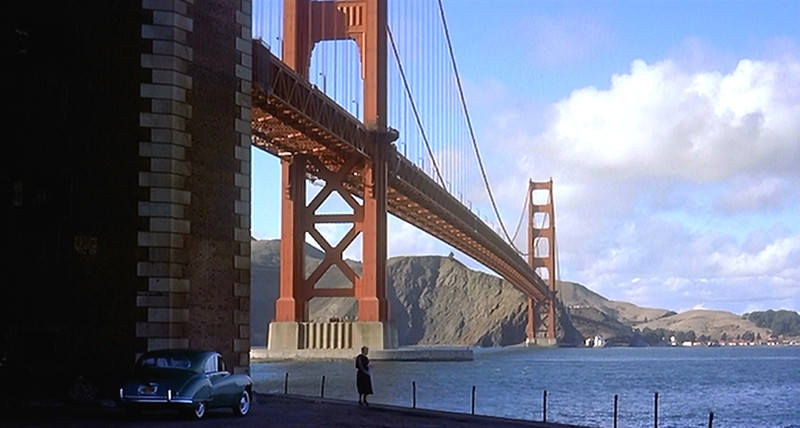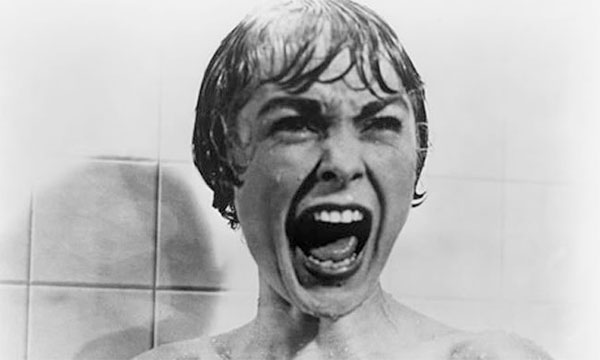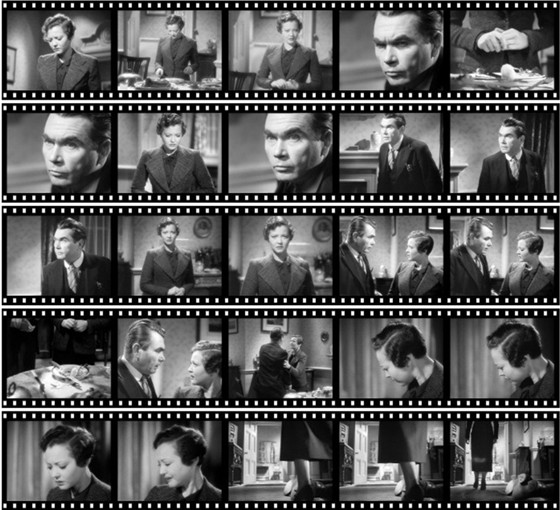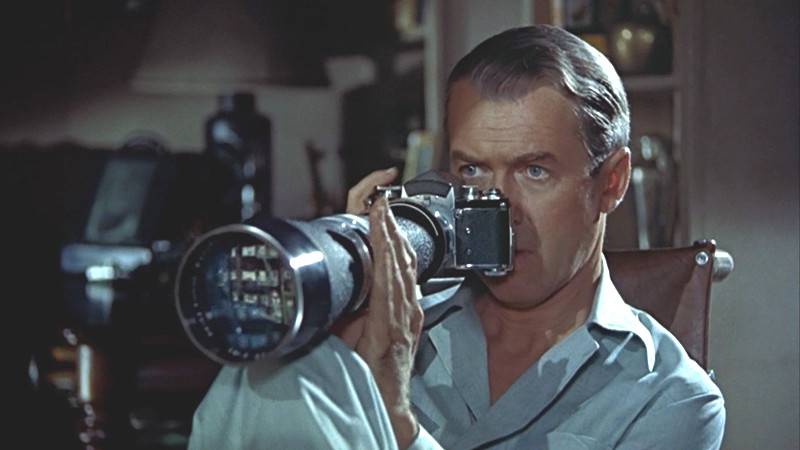Reasons why Hitchcock is able to capture the most demanding moviegoer
Before diving into the listed reasons, the most demanding moviegoer is often that person who looks at film form and studies the various paths the film takes, what use is made of the different elements of cinematic language and, of course, how unity is achieved in the film.
With that being said, this presupposes that the director beyond the ability to put his/hers vision into the film must have knowledge over and intelligently use the various film crafts into the film’s favour.
Hitchcock as film critic Andrew Sarris described is “the only contemporary director whose style unites the divergent classical traditions of Murnau (camera movement and mise-en-scène) and Eisenstein (montage).” So, with that in mind we dive into the next list of reasons.
1. Use of scriptwriting elements

“Ernie, do you realize what we’re doing in this picture? The audience is like a giant organ that you and I are playing. At one moment, we play this note on them and get this reaction, and then we play that chord and they react that way. And someday we won’t even have to make a movie – there’ll be electrodes implanted in their brains and we’ll just press different buttons and they’ll go ‘ooooh’ and ‘aaaah’ and we’ll frighten them, and make them laugh. Won’t that be wonderful?”, this said Hitchcock to his screenwriter Ernest Lehman.
In fact, Hitchcock’s most appreciated talent was the ability of exercising control over the audience and that began with the script in which usually the director had a great participation in (differently from what happened with other directors within a studio system).
So, there are a number of elements which Hitchcock uses in order to play with the audience’s feelings such as the endangered woman (often strong women who see themselves threatened by a concealed danger for instance, Grace Kelly’s character in 1954’s “Dial M for Murder” or Joan Fontaine’s character in 1940’s “Rebecca”), the conception of the wrong man (a quite clear example of this is the two versions of “A Man who knew too much” from 1934 and 1956) and the sympathetic crook (like Cary Grant’s character in 1955’s “To Catch a Thief”) in order to build up sympathy for his characters.
Also noteworthy and effectively used by Hitchcock, are a number of elements which provide his script with an apparent simplicity and narrative economy which ultimately leads to a greater closeness with the audience while providing the film with the necessary spots in its structure to add depth and hidden meanings.
Among these elements is the famous use of the MacGuffin, which consisted in a sort of unimportant detail, narratively speaking, which conceals a necessary first motive to initiate the plot. In his early British thrillers, such as “The 39 Steps” (1935) or “The Lady Vanishes” (1938), the MacGuffins were usually different natures of state secrets.
Also notable is the emphasis Hitchcock puts on the psychological characterization of his characters – main and secondary. A great example of this happens in many of his films, however, Hitchcock first notable achievements were “Rebecca” (1940), “Shadow of a Doubt” (1943), “Rope” (1948) and “Strangers on a Train” (1951).
Particularly, “Rebecca” and “Shadow of a Doubt” introduce us to an element used by Hitchcock: voice over. “Rebecca” is notable for its opening sequence which sends us to the past where Joan Fontaine’s character use to live in the house. It effectively casts a great opening shadow that endures throughout the film giving it a rather gloomy and mysterious aura.
2. Participation in the cinematography and art direction departments

“Hitchcock knew exactly what he wanted to do with this film, exactly what he wanted to say, and how it should be seen and told. I gave him the characters and the dialogue he needed and developed the story, but it was from first frame to last his film.
There was no moment when he wasn’t there. And anyone who saw him during the making of the film could see, as I did, that he felt it very deeply indeed.” These are words of scriptwriter Samuel Taylor on the making of “Vertigo”, however this highlights yet another characteristic of Hitchcock’s style – the necessity for absolute control over the various aspects of filmmaking.
Hitchcock was always very active in other departments outside directing, usually, while accompanying the scriptwriting process, the director used to plan the all film up to its last detail and when shooting began his contributions in the departments of cinematograph and art direction were immense, particularly, through the use of colour and light and shadow.
In his early career, due to contractual obligations, Hitchcock had to work in Germany and there he absorbed many expressionist notions and techniques that he would use throughout his career. These notions were mostly connected with the importance of objects and the produced effects of lighting on sets and characters – this can be perceived most notably in many of Hitchcock’s silent films and early thrillers.
Once in Hollywood, Hitchcock can be accounted as one of the first to use the greater studio conditions and resources (an example of this is the set of “Rope” which is described in “History of narrative film” as: “the camera’s co-star […] an exact miniature replica of some thirty-five miles of New York skyline lighted by eight thousand tiny incandescent bulbs and two hundred neon signs, each wired separately, which marked time by gradually representing the coming of twilight and nightfall to a vault of spun glass clouds”.), as well as, the wide screen and Technicolor process for pictorial and dramatic composition.
3. Hitchcock’s use of music in film

In this third topic, more important than talking and reflecting on the subject is to take Hitchcock’s own words from an interview Hitchcock gave to Stephen Watts somewhere around the 1930s. Some vital ideas are highlighted.
To begin with, Hitchcock does a great portrait of music was used by the industry and its standard conceptions towards it: “(…) The arrival of talkies, as you know, temporarily killed action in pictures (…) but it did just as much damage to music. Producers and directors were obsessed by words. They forgot that one of the greatest emotional factors in the silent cinema was the musical accompaniment. They have gradually realized that action should still come first — that, talkies or not, they are still making motion pictures. But music as an artistic asset of the film is still sadly neglected.”
He continues: “I was greatly interested in music and films in the silent days and I have always believed that the coming of sound opened up a great new opportunity. The accompanying music came at last entirely under the control of the people who made the picture. That was surely an advance on having a separate score played by cinema orchestras. The tremendous advantage of a film being musically accompanied had been demonstrated by ‘silents’ like Ben Hur and Way Down East. Yet when it became possible to blend film and music together in an artistic entity the opportunity was overlooked, or at least left undeveloped. (…) The result is that the only dramatic use of music in talkies — leaving out of account the ‘musicals’ which interpolate ‘numbers’ rather than employ music — is the crude instance of slow music for love scenes. Anything else has been an odd stunt and not a properly worked out scheme. (…) But that conventional soft music is the basis of the right idea — expressing the mood of the scene. It is an elementary application of it.” Of course, “(…) silence is often very effective and its effect is heightened by the proper handling of the music before and after.”
However, the director reflects on other functions of music in film “(…) To create excitement. To heighten tensity. In a scene of action, for instance, when the aim is to build up to a physical clímax, music adds excitement just as effectively as cutting — but I shall have more to say about that comparison later. Music can also be a background to a scene in any mood and a commentary on dialogue, but, frankly. I have not yet made up my mind about the function of music in relation to dialogue in general. I can only give specific instances where I think it might be profitably used. Music with certain types of dialogue might be made to achieve a great deal, and here I can give you an apt illustration from Waltzes from Vienna. There is a dialogue scene between a young man and a woman. It is a quiet, tender scene. But the woman’s husband is on his way. The obvious way to get suspense is to cut every now and then to glimpses of the husband travelling towards the house. In the silent days, when the villain was coming, you always had the orchestra playing quickening music. You felt the menace. Well, you can still have that and keep the sense of the talk-scene going as well. And the result is that you don’t need to insist pictorially on the husband’s approach. (…) It is in that psychological use of music, which, you will observe, they knew something about before talkies, that the great possibilities lie. (…) It makes it possible to express the unspoken.”
To conclude Hitchcock defends that “Film music and cutting have a great deal in common. The purpose of both is to create the tempo and mood of the scene. And, just as the ideal cutting is the kind you don’t notice as cutting, so with music”.
4. Hitchcock’s use of film editing
On this issue, there is plenty to be said, however, like before we’ll rely on the director’s own words and leave its interpretation open to everyone’s subjectivism.
To complement this 7 minute Hitchcock speech here is another excerpt from his interview quoted earlier on the importance of sound in film editing: “I think cutting has definite limitations. Its best use is in violent subjects. That is why the Russians made such effective use of it, because they were dealing with violence, and they could pile shock on shock by means of cutting. But have you noticed that since they started to make quieter subjects, concerned with agriculture, etc., their montage has not been so noticeable or effective? If I am sitting here with you discussing the Five-Year-Plan, no amount of cutting can make a film of us dramatic because the scene is not dramatic. You cannot achieve quiet, restrained effects that way. But you might express the mood and tone of our conversation with music that would illuminate or even subtly comment on it. (…) the basis of the cinema’s appeal is emotional. Music’s appeal is to a great extent emotional, too. To neglect music. I think, is to surrender, wilfully or not, a chance of progress in film-making.”
Also noteworthy is the exploration Hitchcock did of the long take and the effect this element brought upon the film’s editing rhythm and pace and this is something that can be observed more closely in “Rope” (1948) and “Under Capricorn” (1949).
When it comes to a great example of Hitchcock’s greatness in film editing everyone mentions the shower scene is “Psycho” (1960), so in this article, let’s concentrate our attention in this practical example of 1936’s “Sabotage” and how the director manages to present us with a scene in which he conceals the will of a woman to kill her husband and its realization, as well as, the husband’s inner desire to receive such punishment.

Murder sequence in “Sabotage” (1936)
5. Hitchcock’s ability to get great performances from his actors

“I never said all actors are cattle; what I said was all actors should be treated like cattle.” Even though, these words created and still create a lot of controversy among many film critics and actors, they actually make sense within Hitchcock’s directorial style.
Like stated before one of the fundamental characteristics of Hitchcock’s style is the active participation in other filmmaking departments, meaning, to have an absolute knowledge, planning and control over the film. Therefore, it is logical that in his style, Hitchcock places a great deal of importance in performance and in doing so does not allow space to method acting and improvisation.
Hitchcock believed that the building of the characters and its consistency was the responsibility of the duo scriptwriter-director and because he planned the all film long before shooting, which was the moment when actors truly begin their work (until then they just had to shoot promotional materials and some appearances on designated events), he of course had no space for the “actor’s contribution” since this could bring significant changes to the film he had already planned.
Hitchcock expressed his views on method acting: “the method actor is OK in the theatre because he has a free space to move about. But when it comes to cutting the face and what he sees and so forth, there must be some discipline.”
Another element that supports this theory is the fact that Hitchcock frequently collaborated with the same actors and always worked around the same type of persona for his heroes and anti-heroes (persona implies here appearance and not character personality), which, logically, provided him with an already formed image of the character.
And because of these facts all combined Hitchcock was able to get great performances in some cases career defining such as the case of Judith Anderson as Mrs. Danvers in “Rebecca” (1940), Robert Walker as Bruno Anthony in “Strangers on a Train” (1951), the duo John Dall/Farley Granger as Brandon/Philip in “Rope” (1948), Anthony Perkins as Norman Bates in “Psycho” (1960) or Tippi Hedren as Melanie Daniels in “Birds” (1963).
Conclusion:
“Today, Hitchcock is understood to be one of the leading figures in film history, the peer of Griffith, Einsenstein, Renoir, and Welles. About his commitment to style there can be no question – during the thirties, he was one of the few directors to use Einsteinian montage in an era of primarily functional editing; his mastery of the long take and the moving camera have been apparent since the forties; and his achievements in widescreen composition in the fifties are of major historical importance for the contemporary film. Beyond form, however, the is Hitchcock the moralist and fatalist who creates an image of the modern world in which he perilous and the monstrous lurk within the most ordinary circumstances of everyday life. (…) He was an authentic original whose life was his art and who succeeded, perhaps more than any other artist of the century, in making his own fears, obsessions, and fantasies part of our collective psyche.”